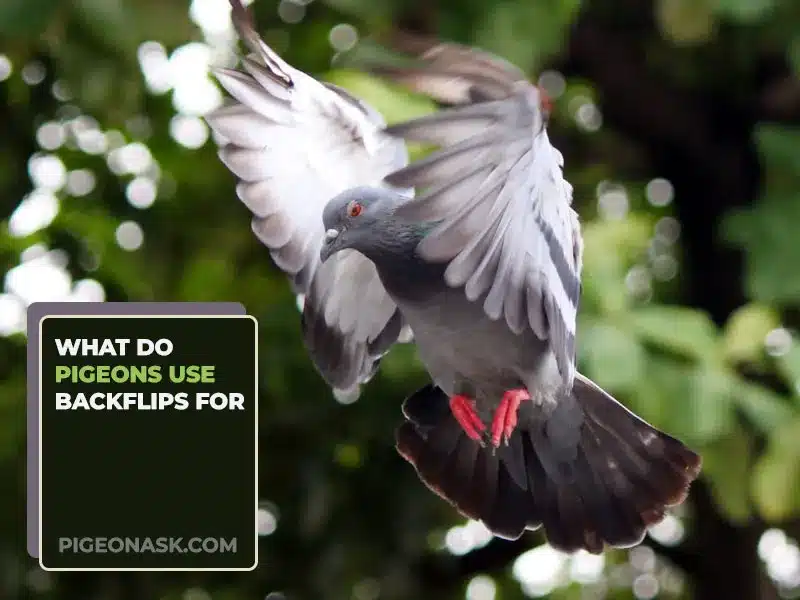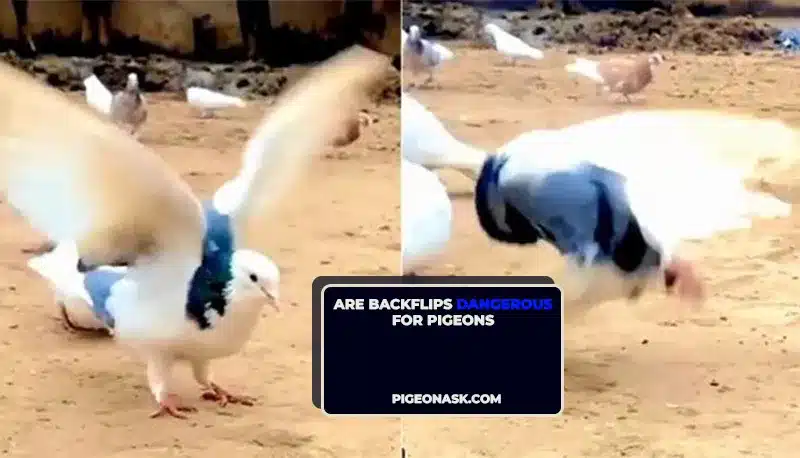Why Pigeons Do Backflips?
Mankind, over the years, has considered backflipping quite amusing, to the point they even trained a specific breed of pigeons through artificial selection.
For those wondering why do pigeons back flip? All Pigeons backflip, and some are trained, some are genetically more geared to perform, and some experience issues with their brain-to-muscle coordination. There are several factors that contribute to pigeon’s backflipping. There is some history behind the phenomenon.
In this article, we will explore all the causes behind backflipping pigeons and some facts from the past that greatly contributed.
Read more about pigeon habits:
What Do Pigeons Use Backflips for?
Initially, backflipping was a survival mechanism for pigeons, and they would do it to confuse their predators and attempt to flee. They have a genetic trait that allows them to spin backward. But back flipping is a result of imbalance, where the brain center is responsible for control and balance.

Similarly, you can train pigeons to do backflips, especially roller pigeons. You can train them to maintain balance before and after backflipping in the air. They must be trained with time and dedication. The backflipping trait is common in professionally trained pigeons.
People have exploited this odd behavior amongst pigeons and selectively bred them to enter competitions where they look for birds that cover the most distance doing somersaults.
We have covered an in-depth article on “Pigeon Habits“; if interested, you can check this article here.
What Would Cause a Pigeon to Backflip?
There are a few key factors when it comes to deducing what could cause a pigeon to backflip. We’ve discussed the actual and interesting reasons behind it in the next section.

01. Imbalance in the Brain Center
The brain of the pigeon is responsible for controlling the flying muscles in the body to ensure stable flying conditions. There are also brain functions that carry out the balancing center tasks.
This center can get damaged if the pigeon just a collision with the head causing injury. Sometimes, these injuries result in ataxia, where they lose control over their flying muscles.
When a pigeon tries to forcefully fly inflicted with ataxia, its flying muscles cannot grasp the right path. This causes pigeons to backflip without knowing the direction.
02. Inherited Trait
Pigeons have inherited a genetic trait that causes them to backflip, backflipping is seen as a defense strategy against predators.
Backflipping causes predators to get confused, and the abrupt movement aids in their survival. The technique requires finesse from the pigeon’s part as accident can occur if the backflips are not done correctly.
An accident will cause stiffening of the flying muscles. As a result, jerks will occur in the pigeon attempting to fly, leading them to do backflips.
The heat and ultraviolet rays will cause pigeons to have a heat stroke which will make them do backflips. Flying at high altitudes can cause this.
03. Encouraged Through Training
It is common to see domesticated pigeons backflip as they are trained for this purpose. The training should be done in a friendly manner as acrobat tricks take time to master.
They are also trained to show intermittent episodes of tumbling during flights. Tumbling is a way of expressing joy for pigeons, and this also increases the duration of their flight.
Both tumbling and backflipping are commonly to be encouraged through training. They are seen in exhibitions or competitions amongst domesticated pigeons.
04. Inability to Fly
Some pigeons cannot fly through selective breeding. Their flight muscles are not strong enough, and when they try to flee, they struggle, causing them to tumble.
These pigeons are bred to lose their ability to fly, but the innate urge to fly is present among them. They are genetically incapable of flying as they were bred for backflipping only, instead of flying they simply walk on the ground.
Do All Pigeons Backflip?
All pigeons can flip back, but a breed of roller pigeons is known particularly for doing backflips. Unlike regular pigeons who can fly, roller pigeons can not fly and rather walk on the ground.
It is common to see them do multiple backflips on the ground to make them stand out. Tumblr pigeons are another breed of pigeons that can fly but they can flip back twice rather than continuous somersaults.

This is the key difference between the two breeds of pigeons.
Records dating back to the mid-19th century show data of how pigeons were carefully selected and bred do backflips.
This selective breeding has led to competitions showcasing the strongest pigeons that are able to execute backflips without struggling.
Are Backflips Dangerous for Pigeons?
Backflips are not dangerous for pigeons unless they land incorrectly and cause injury. Pigeons are specifically bred to do backflips and show no signs of danger when performing such acrobatics.

If the technique and timing are correct, then backflips should pose no threat to the livelihood of pigeons. But do keep in mind that accidents can occur despite our best efforts.
Backflipping is cool, but that is pretty much the idea of it for show. You will not see regular pigeons doing backflips constantly unless the situation demands them to perform.
When training your pigeon, do so with time and dedication in a safe, controlled environment.
Conclusion
Backflips are really fun to watch and do, and chances are, if you are performing, your viewers will be entertained, say the least.
But there is a risk to everything if you boil things down to the core. With pigeons, any incorrect measures when doing backflips can result in serious injuries.
Nevertheless, backflipping has been considered to be an impressive feat regardless of species.
Image Credits:
- Photo from Canva.com/photos
- Photo from Kalinga TV
- Reddit.com/
